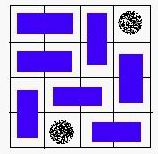Chessboard poj2446(二分最大匹配
Description
Alice and Bob often play games on chessboard. One day, Alice draws a board with size M * N. She wants Bob to use a lot of cards with size 1 * 2 to cover the board. However, she thinks it too easy to bob, so she makes some holes on the board (as shown in the figure below).
We call a grid, which doesn’t contain a hole, a normal grid. Bob has to follow the rules below:
1. Any normal grid should be covered with exactly one card.
2. One card should cover exactly 2 normal adjacent grids.
Some examples are given in the figures below:

An invalid solution, because the hole of red color is covered with a card.

An invalid solution, because there exists a grid, which is not covered.
Your task is to help Bob to decide whether or not the chessboard can be covered according to the rules above.
Input
There are 3 integers in the first line: m, n, k (0 < m, n <= 32, 0 <= K < m * n), the number of rows, column and holes. In the next k lines, there is a pair of integers (x, y) in each line, which represents a hole in the y-th row, the x-th column.
Output
If the board can be covered, output "YES". Otherwise, output "NO".
Sample Input
4 3 2
2 1
3 3
Sample Output
YESHint

A possible solution for the sample input.
Source
POJ Monthly,charlescpp
#include
#include
#include
#include
using namespace std;
int a[2000][2000]={0};
int aa[2000][2000]={0};//再建一个二分图
int bb[4][2]={-1,0,0,1,1,0,0,-1};
int pre[2000];
bool vis[2000];
int n,m,p,cnt;
bool dfs(int l){
for(int i=0;in || yy>m || a[xx][yy]==-1)
continue;
aa[a[i][j]][a[xx][yy]]=1;
}
}
}
}
int sum=0;
memset(pre,-1,sizeof(pre));
for(int i=0;i

